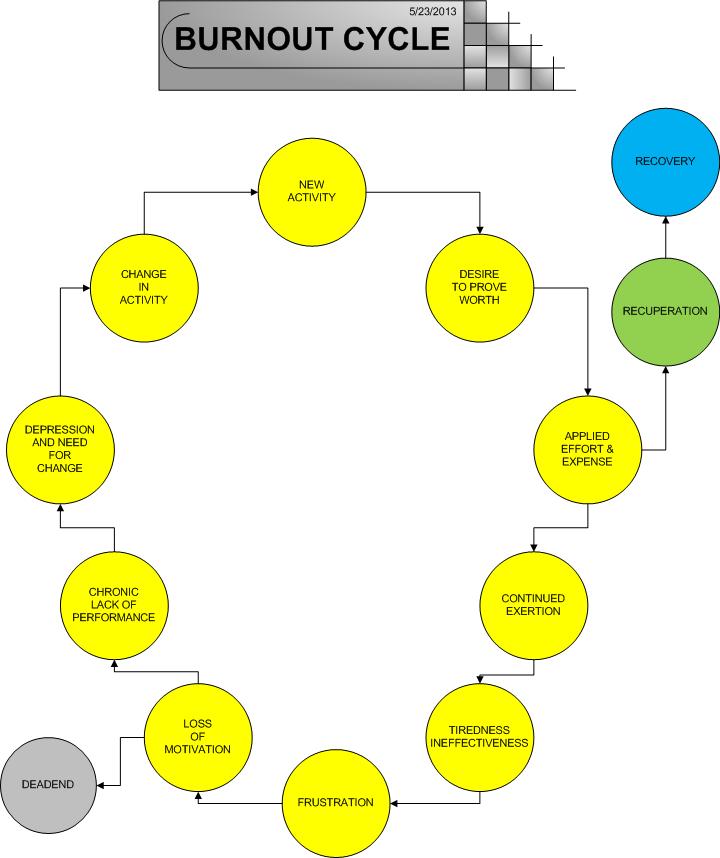Burnout is a state of physical, emotional, and mental depletion. It comes when the stressors and demands put on us outweigh our ability to replenish energy. The consequences of burnout can be profound and, in the worst cases, result in people being unable to function in their daily lives. On the less extreme end, burnout often looks like people going through the motions on the outside while feeling hollow, disconnected, and drained on the inside. Like most mental health conditions, burnout is usually invisible to others and, therefore, can be hard to pick up on until it is already happening. Even from the inside, burnout is often misinterpreted as being stressed or tired and many people think they just need to get more sleep or wait for a particular stressor to pass to feel better. It may not be until the feelings associated with burnout are chronic and/or the experience worsens before people catch on.
Stages of Burnout
Mental health and workplace experts have mapped out various cycles related to burnout. I particularly like this diagram which shows a very detailed exploration of all the moving parts of people’s lives and where burnout can creep in:

As you can see, there are elements of perfectionism, self-esteem and self-worth drivers behind burnout. We all have a fundamental need to be liked and to find value. In this pursuit, we can become so focused on an activity that we forget to take time for recovery and rest. This is, in a nutshell, the recipe for burnout. Overdoing and under resting while operating with a lack of boundaries, competing demands, and an investment in proving one self leads to burnout.
Who is Vulnerable to Burnout?
Everyone is vulnerable to burnout. We are all human beings with demands on our plate and a finite amount of energy in the tank so, therefore, we are constantly walking a fine line with our energy and the risk of burnout. The COVID pandemic has placed unique stressors on society, families, workplaces, and individuals and, therefore, there have been and, will likely continue to be, higher amounts of burnout as we all continue to navigate and heal from this international crisis. COVID has presented an increased risk of burnout by the nature of the stress that it has added to everyone’s systems. For those who were already at maximum capacity with their stress levels, the extra pressure added from everything related to the pandemic may be more than enough to tip someone into the burnout zone.
Factors that make your particularly vulnerable to burnout:
- Being a caregiver of a dependent and/or unwell individual
- Being a healthcare provider
- Being in a high stress, high demand, high pressure work role
- Having multiple demands on your plate
- Having codependent traits
- Being a perfectionist
- Having low self-esteem or self-worth
- Having Addiction (this type of brain has difficulty stopping and can easily get caught up in ‘more, more, more’ and ‘do, do, do’
- Having poor boundaries
- Having difficulty saying “no”
These traits make people more vulnerable as they come in with some built in risk factors for burnout, but even people without these traits may struggle too. Burnout simply comes when there is too much pressure and not enough time in the day to do everything as well as to take care of yourself. While we cannot change how many hours there are in a day, healing from burnout is definitely possible.
Healing from Burnout
Being preventative is obviously the best form of healing as it is easier to implement healthy tools when we are well and have energy than we are compromised in both regards. Sometimes, however, proactive health is not possible or not enough given the situation so keep in mind that all you can do is your best with where you are right now. Are you able to be proactive and implement these healthy coping strategies? Great! Are you struggling from burnout and want to incorporate some of these strategies to support yourself? Great! Wherever you are at, all you can do is your best. It is easy to beat one’s self up over being in the situation of burnout in the first place (and those who are most vulnerable to burnout are also more likely to beat themselves up) so please try to come at your healing with self-compassion and empathy, as you would with others.
Here are some helpful strategies for both proactive and reactive approaches to dealing with burnout:
- Have a routine and schedule that includes gaps of free time. This allows you to incorporate fun, self-care, or adjust for demands that take a different amount of time than you planned
- Build in fun and rest. None of us are robots and we all need time to hydrate, rest, fuel, and rejuvenate. If you are not even sure what fun looks like for you anymore, just build in the time and get experimental from there in exploring how you want to spend your free time
- Start practicing saying “I’ll think about that and get back to you.” This is particularly helpful if saying “no” immediately is not possible. The time delay can help you in identifying if the request is reasonable or not and support you in going back to say no, if needed
- Ask for help. We all hate doing it but we all need it. Nobody can do it all so outsourcing to others where needed can ease some of the pressure you are experiencing
- Be honest about your demands and feelings with yourself and others. Being clearer about what you can and cannot do can help prevent burnout from happening again, as well as provide some freedom in the present
- Treat yourself like you would others. We are always kinder to others than we are to ourselves so taking time to think about what we would want and what we would say to others can give us some tools for dealing with ourselves in a kinder and more realistic way
The key to healing from burnout is to treat yourself with more consideration and tenderness than what has been having. You may need to give yourself extra time to rest and rejuvenate until you feel recovered. Remember your importance and balance your time budget accordingly.


